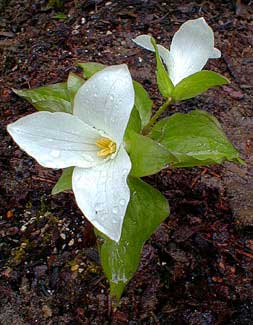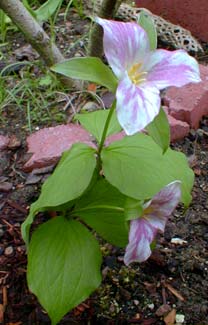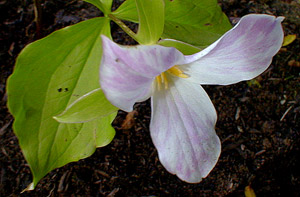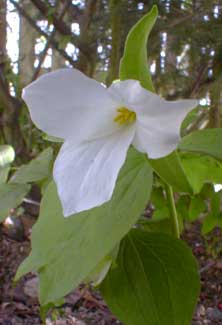
Trillium grandiflorum,
the Snowy Trillium,
or Large-flowered Wake-robin
"A foot as white as trilliums tall--
Musing, the wall we lightly leap.
The spell of Age is over all!
The shaded walks--the shadowy hall."
-Susie Frances Harrison aka "Seranus"
1859-1935
1859-1935
Snowy or Snow Trillium (T. grandiflorum) is also called White Wake-robin, Grand Trillium, Great Flowered Trillium, Large-flowered Wake-robin, Beth Root, Birthroot, or Wood Lily. We planted a young one in a bed of shade plants, where there are several other trillium species as well.
The young specimen shown in the first & second photos was grown from seed by one of our local specialty growers, Sunquist Nursery, who keep threatening to put up a website but have not done so as yet, as I write this. It was only about five or six inches tall & for its first year in our garden it produced two stems with a snow-white flower over each trio of leaves.
 Though these flowers do start out the purest imaginable white, they soon age to violet or sometimes to pink.
Though these flowers do start out the purest imaginable white, they soon age to violet or sometimes to pink.How they age can be quite varied. The second photo taken at the tail-end of April (2003) shows the same pure-white flowers having turned to a stripedviolet!
We obtained another Snowy Trillium for the same shade garden from another source. I had a suspicion they were selling plants snatched from the wild. The plants being sold were of very uneven growth & character, whereas nursery-grown specimens would ordinarily be all the same age & size when prepared for market. But of course the nursery said they were grown from bulbs.
The seller had labeled these possibly kidnapped specimens as "Greater White Trilliums." We bought two, but one of them turned out to be T. erectum. I'd selected this latter intentionally, because it had a shrivelled nearly spent red flower still attached in the nursery, & I was rather hoping it would turn out to be T. grandiflorum roseum, a rare & choice natural variant. But when it produced its smallish maroon flower the following April, it was obviously the more common but certainluy wonderful T. erectum, or Red Wake-robbin.
 So we had bought two additionalT. grandiflorum & got only one. That one is shown in the third & fourth photo in Aprils 2003 & 2004. It is further back in the shade garden growing to the left of one of our local Western Trilliums (T. ovatum) which it greatly resembles. This second specimen starts out pure white (as in the fourth portrait) but quickly develops a soft flush of lilac-purple, as shown in the third portrait.
So we had bought two additionalT. grandiflorum & got only one. That one is shown in the third & fourth photo in Aprils 2003 & 2004. It is further back in the shade garden growing to the left of one of our local Western Trilliums (T. ovatum) which it greatly resembles. This second specimen starts out pure white (as in the fourth portrait) but quickly develops a soft flush of lilac-purple, as shown in the third portrait.Despite so many epithets alluding to the size of the flower, the blooms per se are no bigger than the blossoms of our locally native Western Trillium, though over time it can become a taller bigger plant for its leaves & stems. Both the Western & the Snowy have the largest blooms of any trillium we have.
Snowy Trillium can grow to 18 inches height, is commonly a foot tall, & after many years should be quite an impressive clump of stems, triple-leaves, & three-petalled blossoms.
 The flowers are generally two to three inches across, but sometimes bigger. The petals are usually pointed but occasionally rather rounded. Leaves have the same variation though most commonly pointed. Specimens vary so much in appearance from one plant to the next, & even one year to the next for the same plant, that they can sometimes be difficult to identify.
The flowers are generally two to three inches across, but sometimes bigger. The petals are usually pointed but occasionally rather rounded. Leaves have the same variation though most commonly pointed. Specimens vary so much in appearance from one plant to the next, & even one year to the next for the same plant, that they can sometimes be difficult to identify.All trilliums have three leaves per stem, & three petals per flower. But extremely rare specimens of T. grandiflorum produce four leaves & four petals. Such specimens were reported in An Annotated Flora of the Chicago Area (1927), by Herman Sila Pepoon (1915-1933), & these rare sports have been photographed since. Yet I've never heard of growers developing any that would do this reliably.
When the flower is spent around June, it produces a black fruit which ants cart away to their underground lairs, stripping off its pulp, but not injuring the seed which the ants in essence planted. These take many years to become a bulb that will flower.
When children pick the flowers, it is hardly possible not to take leaves & all, so that the bulb will usually die because it needed those leaves to rebuild strength through photosynthesis. A once very common species is thus dying out over great expanses of its former territory. They should never be molested in the wild, but seed-grown nursery offerings for gardens can help restore them to neighborhoods where they no longer grow wild.